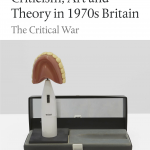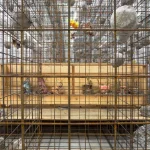My comment on statue-smashing, from Eric Gill to William Colston, for ArtReview
Amid the furious arguments that now surround whether statues should be toppled, destroyed, removed to a museum, ‘interpreted’ or just left where they are, the truth that most statues, most of the time, go unnoticed, is rarely acknowledged. Every day, thousands of Londoners walk past the old entrance of the BBC’s Broadcasting House and never give Prospero and Ariel (1932), installed in an alcove above it, a second glance. But on Wednesday evening, a man scaled a ladder to take a hammer to the sculpture, knocking lumps out of the naked Ariel figure’s feet and legs, and suddenly everyone looked up.
David Chick, a lone protestor previously known for campaigning for custody rights for fathers (in 2003 he occupied a 150ft crane dressed as Spiderman, protesting not being able to see his daughter), also scrawled ‘Noose all paedos’ on the statue, alongside ‘BBC PEADOS (sic) + PROPAGANDA’, and the long-known biography of the sculpture’s maker, British artist Eric Gill, has rushed back into the headlines.
Gill, an eccentric and controversial arts-and-crafts modernist of the early twentieth century, died in 1940. A 1989 biography, drawing from Gill’s own diaries, revealed that he had regularly sexually abused his two young daughters. The revelations shattered Gill’s reputation. But this latest physical attack on Gill’s work has reinflamed the debate over whether it’s possible to separate the quality of an artwork from the deeds of the artist. Chick’s cranky protest comes only days after the ‘Colston Four’ – the protesters involved in pulling down the statue of the English slave-trader Edward Colston during the George Floyd protests in Bristol in June 2020 – were found not guilty of criminal damage, leading some commentators to worry that this would encourage other protestors to take to smashing whatever other statue or monument they object to.
Neither Colston nor Gill are laudable characters, and it would be perverse to weigh the relative virtues of a man who, while later becoming a great local philanthropist and benefactor, headed a company which traded over 80,000 Africans as slaves, against those of an artist who raped his daughters and had sexual relations with his sisters. But Gill was never disgraced or punished for his crimes in his lifetime and many of his works are in national collections and adorn public buildings in Britain, including churches and war memorials. What then, should be done with these works?
Britain is a country still cluttered with the paraphernalia of its colonial and imperial past, a history of oppression and exploitation that many radicals throughout history, from English communists to African and Indian anti-colonialists, fought hard against. But much of the anger at present inequalities, catalysed in the wake of the Black Lives Matter protests, projects contemporary political problems back on to the leftover artefacts of a now distant past.
Many who supported the toppling of Colston would argue that the present and the past cannot be separated, and that current demands for social justice also demand the reordering of such historic public symbols – as one of the Colston Four put it: “We didn’t change history, we rectified it.”
These emotionally-charged acts of ‘rectification’, though, arguably do little to advance social and political progress for British people today, just as Chick’s lone protest does nothing substantial when it comes to protecting children from sexual abuse in the here-and-now. Instead, the focus on toppling statues vests them with an almost mystical, totemic power. But if, as Dan Hicks has argued previously for ArtReview, pulling down statues is ‘not about iconoclasm, but about ridding our cities of the enduring infrastructures of white supremacy’, then everything must come down. How could it stay?
But as this fury has spread, it reinforces the worst, most censorious aspects of ‘cancel culture’. Rather than leave the old relics to the affections of older generations who still have some traditional attachment to them, rather than accept differences of opinion, or that what exists in the public realm should be negotiated by some form of consensus or agreement or democratic process, the demand is always that the public realm be ‘rectified’. This is orthodoxy and conformism masquerading as if it were radical, insurgent outrage. It is definitely one that is hostile to anyone who dissents from its indignant convictions.
That growing culture of orthodoxy, that is now everywhere, turns on a key shift in cultural attitude – that nothing bad or wrong or disagreeable should exist in the public realm. That also means, of course, any cultural artefact of the past that has survived thus far, and which no longer conforms to the etiquettes and values of the present. That this form of intolerance should have taken over culture so quickly signals, ironically, how fearful we seem to have become of the power of dead artefacts. This is backwards superstition and magical thinking, not rational politics. But because it’s fearful and superstitious, it leads to a culture in which one’s emotions, of anger, or injustice, or of just believing that you are right and everyone else is wrong, counts for more than the opinions of others, and justifies any action – even taking a lump-hammer to an artwork, or pulling down an old statue.
But what about Gill? Gill’s public works are not obscene or pornographic, even if their author was a pervert and an abuser. His works are part of a larger art-historical movement and moment, and they have content, form and style that have nothing to do with Gill’s perverted personal life. There is, in some of Gill’s weird, mawkishly sentimental fusion of pagan eroticism, classicism and Christian religious iconography something that may hint, in hindsight, at his own confused and messed up inner life, but his acts, not his art, were his crimes. We can take these into account, but they still cannot explain his work. To erase artworks in the rush to erase artists, though, is leading to a kind of cultural philistinism which, while indifferent to the qualities of artworks, is also contemptuous and dismissive of the opinions of others, and in which only the ‘correct’ way of thinking about public culture is permitted.



